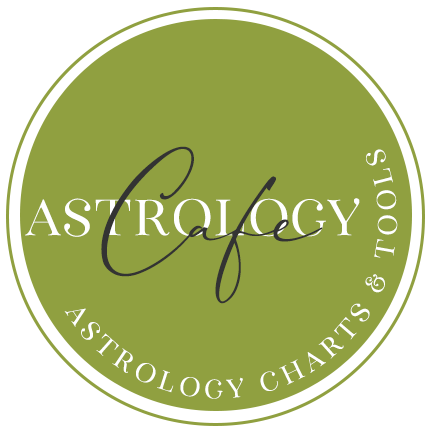The Major Aspects
The Major Aspects in Astrology
![]() The Conjunction: Planets and points that form a conjunction are energies that are united. They are blended; therefore, they act together. The closer they are to conjunction, the more subjective these combined energies are. They don’t stand alone, and they have a difficult time truly acknowledging each other as distinct or separate.
The Conjunction: Planets and points that form a conjunction are energies that are united. They are blended; therefore, they act together. The closer they are to conjunction, the more subjective these combined energies are. They don’t stand alone, and they have a difficult time truly acknowledging each other as distinct or separate.
In effect, conjunctions can be a blind spot. When the Sun is in close conjunction to Neptune, for example, others may note the distinction, but it can be hard for the native to distinguish between their sense of individuality and their spiritual, evasive, or roundabout nature. The native may just assume, naturally, that others are much the same way.
![]() The Sextile: The sextile is often read quite like a trine, although there is a distinction between the two aspects. Sextiles, like trines, point to some talent and ease. However, sextiles have a little more “oomph” to them. While trines come so naturally to people that they might have to be reminded of their own talents or tendencies, sextiles are a little more overt to the native. These are the talents that people appreciate in themselves. They may be more inclined to notice and work on these talents.
The Sextile: The sextile is often read quite like a trine, although there is a distinction between the two aspects. Sextiles, like trines, point to some talent and ease. However, sextiles have a little more “oomph” to them. While trines come so naturally to people that they might have to be reminded of their own talents or tendencies, sextiles are a little more overt to the native. These are the talents that people appreciate in themselves. They may be more inclined to notice and work on these talents.
Sextiles are communicative and relationship-friendly aspects. They point to energies that are capable of being directed. Sextiles reveal the potential for intelligent use of the energies.
![]() The Square: This aspect creates tension between the planets and points involved. Tension is necessary in order to stimulate action, but too much tension translates to stress. The planets involved in a square are acting at cross purposes. With squares, we may overdo and run into countless obstacles before we “get it right”. However, squares force us out of complacency and get the ball rolling. Squares are often more difficult when we are young, as these aspects force us to grow and learn our lessons.
The Square: This aspect creates tension between the planets and points involved. Tension is necessary in order to stimulate action, but too much tension translates to stress. The planets involved in a square are acting at cross purposes. With squares, we may overdo and run into countless obstacles before we “get it right”. However, squares force us out of complacency and get the ball rolling. Squares are often more difficult when we are young, as these aspects force us to grow and learn our lessons.
![]() The Trine: Planets in trine support each other. Trines, by nature, are accepting. They allow us to accept others, ourselves, and situations. The talents that trines offer a native are so natural that they are almost unconscious. Often enough, natives don’t truly appreciate the talents these trines offer them, and they may not try to develop them.
The Trine: Planets in trine support each other. Trines, by nature, are accepting. They allow us to accept others, ourselves, and situations. The talents that trines offer a native are so natural that they are almost unconscious. Often enough, natives don’t truly appreciate the talents these trines offer them, and they may not try to develop them.
However, these talents are second nature and completely natural. So, for example, if a man has Venus trine Neptune, he may be poetic, romantic, or artistic, and he may easily accept his romantic partner for who he/she is. Another man with Venus square Neptune may have similar qualities and may possess a strong desire to accept his partner blindly, but doing so is not as natural as the first man. He has to work on it and might come up against difficult situations in which he feels duped or abused by his partners as a result of that acceptance.
![]() The Opposition: “It takes two” is the expression, and the opposition is created by dividing the circle by 2. Therein lies the key to the meaning of this aspect: relationship. People with oppositions seek out others as if to mirror their own internal struggles. They learn about themselves through interactions with others. Very often, oppositions cause us to swing from one side to the other and we feel torn.
The Opposition: “It takes two” is the expression, and the opposition is created by dividing the circle by 2. Therein lies the key to the meaning of this aspect: relationship. People with oppositions seek out others as if to mirror their own internal struggles. They learn about themselves through interactions with others. Very often, oppositions cause us to swing from one side to the other and we feel torn.
Oppositions represent a state of divided loyalties. Inner discontent, uncertainty, and insecurity can be a result. While a square is urgent and courageous, an opposition is unsure and wavering. When we use our oppositions correctly, we are more willing to consider the other side and we can be adept negotiators.
Difference between sextiles and trines: Both aspects show us planet “buddies” who get along. But the trine buddies may take each other for granted even though they derive pleasure from each other, while the sextile buddies remain separate somehow, and when they cooperate with each other they fully appreciate their “friendship.”
The expression of the trine is very natural and automatic, while the energies created with the sextile are things that can be drawn upon if need be. With trines, the energies tend to flow naturally into constructive channels, and with sextiles, a conscious effort is required to push the energies into constructive channels.
Difference between oppositions and squares: Squares create the kind of tension that demands action. Oppositions also create tension, but natives generally seek out others in relationships in order to work out that tension! Note that planets in opposition generally occur with compatible sign elements, while squares generally occur between signs that are considered incompatible by element.
Predominant aspects in a chart:
conjunctions – focused people, derive their motivation from within; with not enough oppositions, hard to see the other side, easy to lose perspective.
sextiles – communicative, creative, expressive.
squares – crisis-oriented people, action-oriented, motivated, willing to tackle obstacles, don’t blindly accept things, energetic, strength of character and will.
trines – unchallenged, talented, accepting, comfortable, complacent.
oppositions – contradictory, seek balance in their lives usually through relationships, insightful, they look for meaning in life, inclined to project qualities onto others, unfocused, greater capacity for objectivity, seek growth through relationships.
Lack of aspects in a chart:
conjunctions – scattered, don’t look within for answers, flexible.
sextiles – inclined to avoid creative pursuits, are less self-expressive and communicative.
squares – lack motivation, take the easy way out, avoid confrontations, unchallenged, habitual people.
trines – not as balanced people, conflict-oriented, driven.
oppositions – subjective, don’t need partners to mirror themselves, self-contented, not as concerned about growing through relationships or broadening their own perspective, self-reliant.
![]()
An Exercise in Self-Awareness
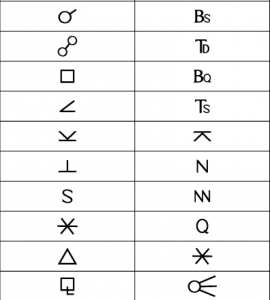 The closer the aspect, the more unconscious and habitual it is likely to be. Interestingly, I have found that we tend to identify more with aspects with wider orbs. Aspects with larger orbs are usually dynamics of our personalities that are most obvious to us, while others in our lives may notice the energies of our closer aspects more than we do.
The closer the aspect, the more unconscious and habitual it is likely to be. Interestingly, I have found that we tend to identify more with aspects with wider orbs. Aspects with larger orbs are usually dynamics of our personalities that are most obvious to us, while others in our lives may notice the energies of our closer aspects more than we do.
This is because close aspects are very subjective and habitual. They are so much a part of us that we may not pay much attention to the personality dynamics that they represent. With experience and increased self-awareness (as well as feedback from others), we come more in touch with these instinctive facets of our personalities. Of course, astrology can help us better understand these dynamics.
As students of astrology, once we have reached the point where we have “proved” to ourselves that astrology works, the following exercise can be extremely rewarding and insightful. Stop to think about each aspect in your chart and accept that it is part of you. Abandon the idea that any one aspect is more powerful than another, just for the duration of this exercise. Allow yourself to accept that each aspect you see in your chart is valid energy in your life.
The basis of this exercise is acceptance. In our early studies of astrology, we tend to pick and choose which aspects and positions in our charts are “most like” us. We think in such terms as, “Oh, this is ME!”, “This aspect is kind of like me”, and, “This is not really me”. This is a natural process, as we are still attempting to prove that astrology works (or doesn’t work). As well, we are not yet open to the fact that although we live with ourselves every moment, we do not know ourselves all that well!
By picking and choosing which aspects and positions jive with our images of ourselves, we miss out on the insight that is astrology’s gift. Each and every aspect in our chart–whether it’s tight or wide, angular or not–is ours. By accepting this concept, we serve to gain tremendous insight into our personalities. We increase our awareness and mindfulness.
For a discussion of the quincunx or inconjunct aspect, see The Quincunx/Inconjunct in Astrology.
For interpretations of the planetary aspects in a natal chart, see Planetary Aspects.
You May Also Like:
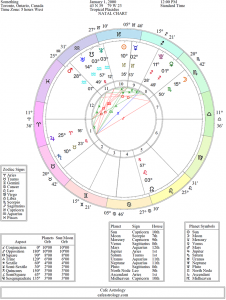
How to Find a Birth Date from a Birth Chart
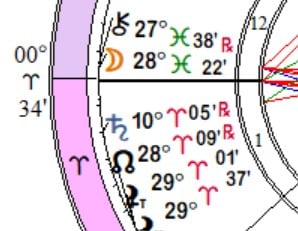
Accuracy of Degrees (and Minutes) of the Ascendant

Understanding the Free Natal Chart Report

Understanding the Astrological Chart Wheel

Astrological Houses: Divisions

Compare House Systems Report
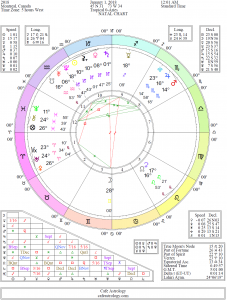
Get Your Astrology Natal/Birth Chart
See Also:

